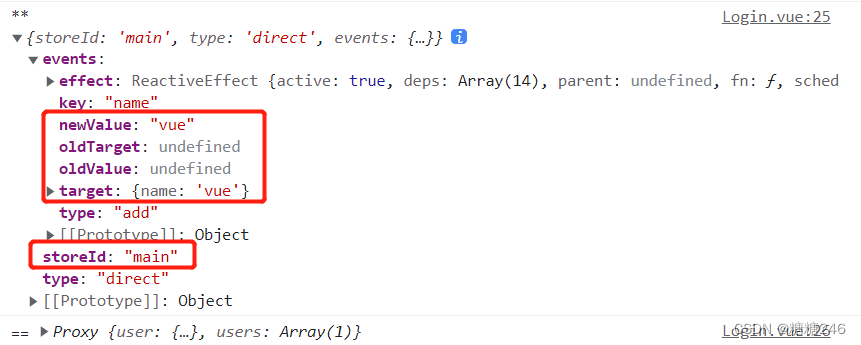在根目录下新建store文件夹,在文件夹下新建index.ts文件
一. src>>store>>index.ts文件中创建store
import { defineStore } from 'pinia'
interface State { }
export const useUserStore = defineStore('main', {
state: ():State => ({ }),
//类似于computed
getters: { },
//类似于methods
actions: { }
})二.在组件中应用store
<template>
<div class="page">
用户名: {
{user.name}}
<a-button type="primary" @click="changeName">修改用户名</a-button>
</div>
</template>1. 读取state中的属性
<script setup lang="ts">
import { useUserStore } from '@/store'
const user = useUserStore()
</script>2.state值的六种改变方式
(1)直接修改
<script setup lang="ts">
import { useUserStore } from '@/store'
const user = useUserStore()
const changeName = () =>{
user.name = '后端'
}
</script>(2)$patch批量修改
该修改方式需要定义store的时候,并没有对state函数返回值做类型限制,且批量修改只能修改state函数返回值中已存在的属性
<script setup lang="ts">
import { useUserStore } from '@/store'
const user = useUserStore()
const changeName = () =>{
user.$patch({
name: 'vue',
age: 4,
})
}
</script>(3)$patch带逻辑修改
该中方式支持创建store时对state函数返回值类型限定,
-- 若限定中可以有任意属性,则可以添加state中没有的属性
-- 若没有返回值类型限定,则只能修改创建state时已存在的属性
<script setup lang="ts">
import { useUserStore } from '@/store'
const user = useUserStore()
const changeName = () =>{
user.$patch(state => {
if(..){
state.name = 'react'
state.type = '前端'
}
})
}
</script>(4)$state替换state
<script setup lang="ts">
import { useUserStore } from '@/store'
const user = useUserStore()
const changeName = () =>{
user.$state = {
userId: '666',
name: 'vscode',
age: 18
}
}
</script>(5)借助actions方法
src>>store>>index.ts
actions: {
changName(name:string){
this.name = name
}
}组件中
<script setup lang="ts">
import { useUserStore } from '@/store'
const user = useUserStore()
const changeName = () =>{
user.changName('333')
}
</script>(6)使用$reset重置state
const store = useStore()
store.$reset()3.借助 storeToRefs 解构state
<script setup lang="ts">
import { storeToRefs } from "pinia";
import { useUserStore } from '@/store'
const { name } = storeToRefs(useUserStore())
const changeName = () =>{
name.value = '111'
}
</script>4. actions
可以直接this.xx访问到state中的属性,也可以this.xxx访问到actions中的方法
(1) 处理同步逻辑
actions: {
changName(name:string){
this.name = name
},
}(2) 处理异步逻辑
import { defineStore } from 'pinia'
interface User {
userId: string,
name: string,
age: number,
[propName: string]: any
}
const login = ():Promise<User> => {
return new Promise(resolve => {
setTimeout(()=>{
resolve({
userId: '666',
name: '333',
age: 4
})
},1000)
})
}
export const useUserStore = defineStore('main', {
state: () => {
return {
user: <User>{}
}
},
//类似于computed
getters: {
},
//类似于methods
actions: {
changName(name:string){
this.user.name = name
},
async setUser(){
const userInfo = await login()
this.user = userInfo
}
}
})5.getters
需要定义返回类型,可以在定义常规函数时通过this访问到 整个 store 的实例
(1)函数式写法
//类似于computed
getters: {
enName():string{
return this.user.name
}
},(2)接收参数
state: () => {
let users: Array<User> = []
return {
user: <User>{},
users,
}
},
//类似于computed
getters: {
getUserById: (state) => {
return (userId:string) => state.users.find((user) => user.id === userId)
}
},组件中应用
<template>
<div class="page">
用户名: {
{store.user.name}}<br>{
{store.users}}<br> {
{ store.getUserById('666') }}
<br>
<a-button style="margin-right:10px" type="primary" @click="changeName">修改用户名</a-button>
<a-button type="primary" @click="addUser">添加用户名</a-button>
</div>
</template>
<script setup lang="ts">
import { useUserStore } from '@/store'
const store = useUserStore()
const changeName = () =>{
store.user.name = 'vue'
}
const addUser = () =>{
const user = {
userId: '666',
name: 'react',
age: 4
}
store.users.push(user)
}
</script>6.组件中对store实例方法的使用
(1)借助$subscribe监测state值的变化
state中的值发生改变,则会触发 $subscribe 函数,接收一个箭头函数,箭头函数会内部传递两个参数,第一个参数为对变化的监控,第二个参数为修改后的state
store.$subscribe((arg, state)=>{
console.log('**',arg)
console.log('==',state)
},{ //第二个参数为配置对象
detached: true, //组件销毁后依然监测state值的变化
deep: true, //深度监测
flush: 'post', //回调的刷新时机 pre默认值,dom更新前调用 sync同步调用 post dom更新后调用
immediate: true, //立即触发一次
})
(2)借助$onAction监测actions中方法的调用
store.$onAction(arg=>{
console.log('//', arg)
arg.after(()=>{
console.log('123')
})
}, true) //true为第二个参数,可以不写,写上表示组件销毁后依然监测actions的调用情况
三.借助插件实现持久化保存数据(刷新不丢失)
同vuex一样,刷新页面的时候,store中的数据会重置为初始化,但是pinia支持通过插件将数据保存到 localStorage/sessionStorage/cookie 中
1. src>>plugins>>piniaPlugin.ts
import { PiniaPluginContext } from 'pinia'
import { toRaw } from 'vue'
type Options = {
key?: string,
type?: string
}
const _piniaKey:string = 'pinia'
const _type = 'session'
const setStorage = (key:string, value: any, type:string) => {
switch (type) {
case 'session':
sessionStorage.setItem(key, JSON.stringify(value))
break
case 'local':
localStorage.setItem(key, JSON.stringify(value))
break
}
}
const getStorage = (key:string, type:string) => {
let data:any
switch (type) {
case 'session':
data = sessionStorage.getItem(key) ? JSON.parse(sessionStorage.getItem(key) as string) : {}
break
case 'local':
data = localStorage.getItem(key) ? JSON.parse(localStorage.getItem(key) as string) : {}
break
}
return data
}
const piniaPlugin = (option: Options) => {
return (context: PiniaPluginContext) => {
const { store } = context
const data = getStorage(`${option?.key ?? _piniaKey}-${store.$id}`, `${option?.type ?? _type}`)
store.$subscribe(() => {
setStorage(`${option?.key ?? _piniaKey}-${store.$id}`, toRaw(store.$state), `${option?.type ?? _type}`)
})
return {
...data
}
}
}
export default piniaPlugin2.修改mian.ts
import { createApp } from 'vue'
import App from './App.vue'
import router from '@router/index'
import { createPinia } from 'pinia'
import piniaPlugin from './plugins/piniaPlugin'
const store = createPinia()
store.use(piniaPlugin(
{
key: 'pinia',
type: 'local'
}
))
const app = createApp(App)
app
.use(store)
.use(router)
.mount('#app')